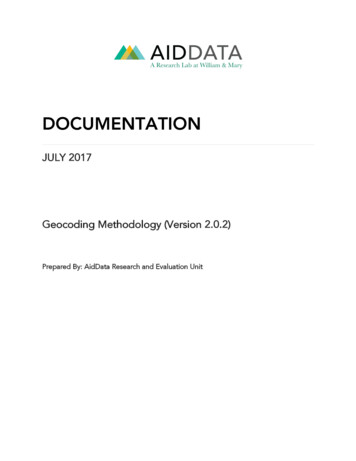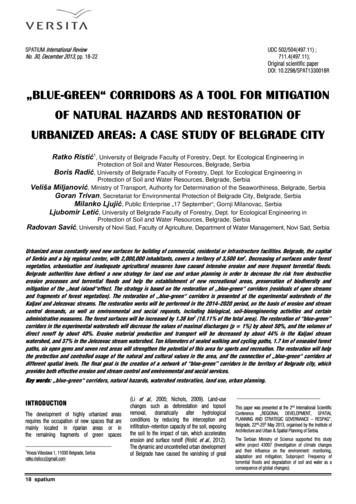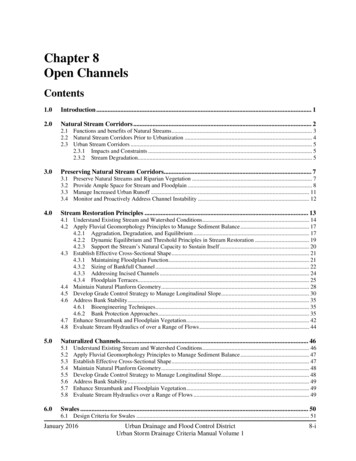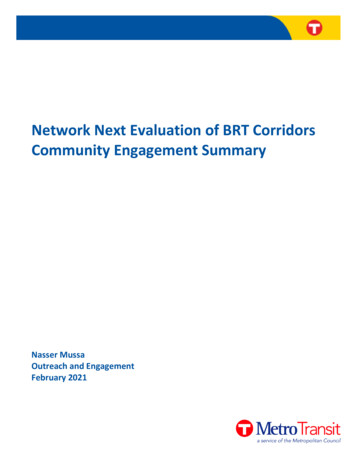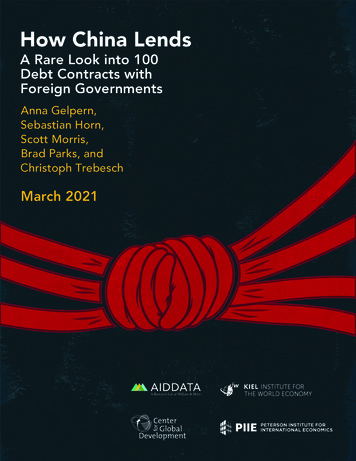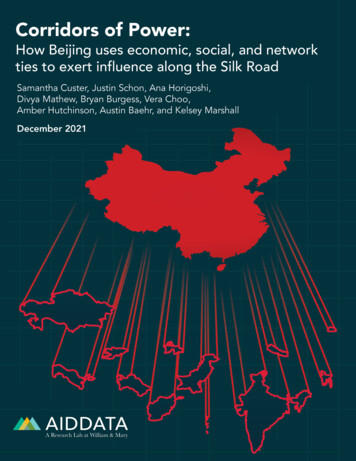
Transcription
Corridors of Power: How Beijinguses economic, social, and networkties to exert influence along theSilk RoadFull Manuscript, v9.7DECEMBER 11, 2021i
AcknowledgementsThis report was prepared by Samantha Custer, Justin Schon, Ana Horigoshi, Divya Mathew, BryanBurgess, Vera Choo, Amber Hutchinson, Austin Baehr, and Kelsey Marshall (AidData, William & Mary).The findings and conclusions of this report are those of the authors alone and do not necessarily reflectthe views of the funders and contributors we thank below.Rodney Knight supported the research design and quality assurance process to ensure our methods wereappropriate to the task at hand and the results carefully verified for accuracy. Christian Baehr oversaw theprocess of geo-referencing our data to allow us to gain more granular insights on the breadth and depthof China’s overtures at the subnational level. Ammar A. Malik provided helpful feedback on the findingsand conclusions. We thank the respondents who graciously answered our snap poll survey questions,sharing their insights on their perceptions of foreign powers across the South and Central Asia region,their views of these powers’ public diplomacy efforts, and their level of current and desired foreignlanguage proficiency. We appreciate several subject matter experts who shared their time and insightswith us in background interviews in preparation for this report. Our AidData Communications team—JohnCuster, Sarina Patterson, and Parker Kim—were instrumental in creating high-impact visuals, along withthe final formatting, layout, and editing which we hope make this report more engaging for you to read.As the second report in this series on China’s influence in South and Central Asia, we stand on theshoulders of colleagues who helped collect and analyze the preliminary data on China’s public diplomacythat offer an empirical foundation for this report. We owe a debt of gratitude for their efforts, including to:Tanya Sethi, Jonathan A. Solis, Joyce Jiahui Lin, Siddhartha Ghose, Anubhav Gupta, Katherine Walsh,Brooke Russell, Molly Charles, Steven Pressendo, Wenyang Pan, Paige Jacobson, Ziyi Fu, KathrynnWeilacher, Caroline Duckworth, Xiaofan Han, Carlos Holden-Villars, Mengting Lei, Caroline Morin, WenzhiPan, Richard Robles, Yunji Shi, Natalie White, Fathia (Fay) Dawodu, Carina Bilger, Raul De La Guardia,Xinyao Wang, and Lincoln Zaleski. In addition, we drew upon an expanded team of research assistants tosupport a range of supplemental data collection that added new insights to this second report, including:Hanna Borgestedt, Riley Busbee, Megan Steele, Mikayla Williams, Sarah Dowless, Claudia Segura,Alondra Belford, Eric Brewer, Daniel Brot, Grace Bruce, Gabriella Cao, Makayla Cutter, Cassie HeymanSchrum, Maureen Lewin, Holden Mershon, Noelle Mlynarczyk, Ankita Mohan, Cassie Nestor, Grace Riley,Christopher Rossi, Dongyang Wang, Rachel Yu, Merielyn Jiangcheng Sher, Xiatian Kate Chu, IsaacPoritzky, Nawate Wani, Lena Zheng, Keely Wiese, Wanggxinyi Freda Deng, Yingyue Abi Xu, SihanMichelle Zhou, Fei Wu, Shan Kelly Gao, Rui Ray Shen, Yuchieh Cheng, Xinyao Louise Lin, Jessica YongyiLiu, and Jacob Barth.This report was made possible through generous support from the United States Department of Stateand the Ford Foundation. We would also like to acknowledge the invaluable contributions of the AsiaSociety Policy Institute and the China Power Project of the Center for Strategic and International Studiesto an earlier phase of in-country interviews and a related report, Silk Road Diplomacy, that provided animportant intellectual foundation for this second phase of work.CitationCuster, S., Schon, J., Horigoshi, A., Mathew, D., Burgess, B., Choo, V., Hutchinson, A., Baehr, A., and K.Marshall (2021). Corridors of Power: How Beijing uses economic, social, and network ties to exertinfluence along the Silk Road December 13, 2021. Williamsburg, VA. AidData at William & Mary.Version 1.0.1. This version corrects mistakenly switched the labels for Figure 5 in the previous version.AppendixTo access the technical appendix for this report, please refer to the electronic version which can be foundonline at: r.ii
Contents1. Introduction11.1 Exerting influence via economic, social, and network ties22. Economic ties: How wide and deep is Beijing’s financial diplomacy footprint among South and Central Asiancommunities?42.1 Following the money: Beijing’s financial diplomacy across countries42.2 Investment hotspots: Beijing’s financial diplomacy within countries72.3 Financial diplomacy in an era of great power competition3. Social ties: How does Beijing leverage education, culture, and exchange to amplify its foreign influence strategy?3.1 Education as soft power: Beijing’s educational assistance and student exchange efforts1014143.2 Chinese language and culture promotion: The gravitational pull of Mandarin as a gateway to economic opportunity223.3 Physical networks: Fostering people-to-people ties between cities and provinces284. Network ties: How does Beijing use social media to expand its reach with South and Central Asian leaders and publics?344.1 Mapping networks: How closely connected is the PRC with SCA elites on Twitter?344.2 Identifying brokers: Whose voices matter most to the PRC’s ability to amplify preferred messages with SCA elites onTwitter?424.3. Analyzing mentions: Who is talking to whom and how prominent are PRC accounts?5. Tying things together: How do citizens and leaders in SCA countries view the PRC versus other great powers?47525.1 Grassroots perceptions: How do SCA citizens view the PRC relative to its competitors?525.2. Public diplomacy and citizen perceptions: To what extent are the PRC’s overtures associated with a favorableresponse among SCA citizens?565.3. How do SCA elites perceive China and its strategic competitors?596. Conclusion66References70iii
FiguresFigure 1: Beijing’s financial diplomacy by SCA country, 2000-20175Figure 2: Beijing’s subnational financial diplomacy (logged) by SCA country, 2000-20178Figure 3: Geographic distribution of educational assistance project counts, by country and time period15Figure 4: SCA students studying abroad in China annually by country, 2010-201717Figure 5: Comparative visa requirements for SCA students in the PRC, Russia, the US, and the UK19Figure 6: Cumulative number of American Spaces and Confucius Institutes in South and Central Asia, 2000-201825Figure 7: Language and culture centers run by Russia, China, and the US26Figure 8: Sister city relationships between the PRC and SCA countries, 2000-201829Figure 9: Sample of SCA and PRC elites on Twitter, by country36Figure 10: How connected is a country’s social network on Twitter?37Figure 11: Distribution of connections for handles from a given country38Figure 12: How connected are SCA and PRC elites on Twitter?39Figure 13: How connected are Kazakhstan and PRC Twitter communities?40Figure 14: How connected are Pakistan and PRC Twitter communities?41Figure 15: To what extent do SCA and PRC elites mention each other on Twitter?47Figure 16: Distribution of mentions across Twitter handles, by country49Figure 17: SCA citizen approval rates of foreign powers, 2006-202055Figure 18: Relationship between high-level visits by PRC leaders and SCA citizen approval rates58Figure 19: Elite perceptions of the PRC versus strategic competitors in SCA, 202160Figure 20: Reasons why elites held favorable attitudes towards the US and PRC, 202161Figure 21: Activities elites associate with foreign powers in their country, 202162Figure 22: Which foreign power did elites view as adapting their public diplomacy most effectively to COVID-19?62Figure 23: Areas SCA elites suggest the US and PRC should focus on to improve favorability63iv
TablesTable 1: Beijing’s three subnational public diplomacy strategies: Extract, nudge, avoid6Table 2: Possible factors driving Beijing’s financial diplomacy allocations9Table 3: Number of educational assistance projects, by country and time period16Table 4: Number of PRC educational assistance projects by category, all SCA countries, 2000-201716Table 5: PRC state-backed scholarships for SCA students studying in China21Table 6: Indian government scholarship programs in which SCA countries are named21Table 7: Number of Chinese top-tier HEIs offering English or Russian medium of instruction, by institution type22Table 8: Total number of Confucius Institutes and Classrooms in SCA countries, 2004-201824Table 9: Language and cultural centers of PRC and rival powers in the SCA region, 201825Table 10: Reported fluency and interest in English, Mandarin, and Russian, snap poll survey responses, 202127Table 11: Two types of socio-cultural ties at the city or province level28Table 12: Top 16 cities by touchpoints to the PRC30Table 13: Key concepts in understanding Twitter network analysis35Table 14: Differentiating between four types of brokers42Table 15: Top PRC representatives interacting with SCA elites43Table 16: Top PRC gatekeepers interacting with SCA elites44Table 17: Top SCA gatekeepers for each country45Table 18: Top SCA representatives by country46v
AcronymsBRI – Belt and Road InitiativeCCP – Chinese Communist PartyCCTV – China Central TelevisionCGTN – China Global Television NetworkCI – Confucius InstituteCPEC – China-Pakistan Economic CorridorCRI – China Radio InternationalGWP – Gallup World PollHEIs – Higher Education InstitutionsHSK – Hanyu Shuiping KaoshiICCR – India Council for Cultural RelationsIPI – Iran-Pakistan-India PipelineMEA – Ministry of External Affairs, IndiaPRC – People’s Republic of ChinaPSGP – PakStream Gas PipelineSCA – South and central AsiaTAPI – Turkmenistan-Afghanistan-Pakistan-IndiaUK – United KingdomUS – United Statesvi
CHAPTER ONEIntroduction1. IntroductionIn July 2021, the People’s Republic of China (PRC) joined fiveSouth Asian countries to launch new platforms to orchestrateregional cooperation on COVID-19 vaccination, climatechange, and poverty alleviation (Ghimire and Pathak, 2021;Gautam, 2021).1 Missing was Beijing’s proximate rival forinfluence in South Asia—India. The fanfare of the PRC-ledcooperation prompted unflattering comparisons to theSouth Asian Association for Regional Cooperation (SAARC),hampered by unresolved disputes between India andPakistan (Agarwal, 2021; Giri, 2021). Earlier in May 2021,PRC Foreign Minister Wang Yi announced with five CentralAsian counterparts a series of cooperative initiatives—fromagriculture and education to cultural heritage and traditionalmedicine (Devonshire-Ellis, 2021; China MFA, 2021). He alsosought to cast the PRC as an ally supporting reconstructionin Afghanistan and laid ground for the country to join theChina-Central Asia (C C5) bloc, in which Russia is noticeablyabsent, in future (ibid).et al., 2021a).2 Its efforts to cultivate sympathetic local media(e.g., journalist exchanges, op-eds and interviews in SCAmedia) have been associated with more favorable views ofPRC leadership and a chilling effect on critical coverage ofBeijing’s policies (Custer et al., 2019a and 2019b). Inaddition, countries that received more attention fromBeijing, particularly in the form of visits from PRC elites, andfinancing on generous terms tended to have lower rates ofdisapproval of PRC leadership (ibid).Yet, Beijing’s willingness to bankroll an ambitious publicdiplomacy program has provoked mixed reactions in SCAcountries. Some value Beijing’s attention and investments intheir economy, viewing its development story as one towhich they aspire and an opportunity to assertindependence from status quo regional powers such as Indiaand Russia. For others, the PRC’s bid for influence recallstales of debt distress, quid pro quo dealings, and beingpulled into a geostrategic tug of war between great powersin an era of heightened competition. Moving frommarshalling inputs to achieving one’s desired outcomes isneither straightforward, nor quick. Nye (1990; 2003) calls thisthe “paradox of power”: countries with the greatestresources or capabilities (potential power) do not always getthe outcomes they want (realized power). The PRC mustovercome a conversion dilemma—the ability to influencechanges in public attitudes and leader behavior in ways thatalign with their objectives (ibid).Both episodes illustrate Beijing’s healthy appetite to winover foreign leaders and publics in what the PRC considersits “greater periphery” (Li and Yuwen, 2016). Moreover, theyspotlight Beijing’s multidimensional influence playbook as itseeks closer economic, social, and network ties with Southand Central Asian (SCA) countries to advance its nationalinterests. Public diplomacy refers to a collection ofinstruments used to influence the perceptions, preferences,and actions of foreign leaders and citizens. This includesefforts to export culture and language, foster people-topeople ties, cultivate relationships with other leaders, shapemedia narratives, and employ the power of their purse towin friends and influence people. These ties fosterinterdependence between economies and societies thatpresent both opportunities and vulnerabilities (Nye, 2021).In 2019, AidData, a research lab at William & Mary’s GlobalResearch Institute, collected and analyzed data tounderstand how Beijing deployed five public diplomacyinstruments—financial, information, cultural, exchange, andelite-to-elite diplomacy—to shape public opinion and leaderbehavior in 13 SCA countries (Custer et al., 2019a). Using amixed methods approach, the authors shed light on whichtools Beijing used, with whom, and to what end. They alsosought to understand how public diplomacy might advanceBeijing’s national interests—from more favorable popularperceptions to discrete economic, foreign policy, andsecurity concessions.This bid to exert influence is not new; PRC leaders have longviewed the thirteen SCA countries as a geostrategic priorityand a fulcrum of power (Scobell et al., 2014). Over the pasttwo decades, Beijing has employed the full range of itseconomic and soft power tools to manage negativereactions in SCA countries to its growing military andeconomic might, while building a coalition of countrieswilling to back its preferred policy positions in internationalfora. Doshi (2021) describes PRC leaders as playing a “longgame” to displace status quo powers in a bid for regionaland global hegemony that has grown in assertiveness overtime. Beijing’s aims may be long-standing, but its strategy—the intentional, synchronized use of multiple tools ofstatecraft to advance national interests—has evolved inresponse to perceived threats and the relative strength of itsstrategic competitors (ibid).The first report answered some questions but raised newones. In parallel, the arrival of the COVID-19 globalpandemic provided new avenues for competition betweenstates jockeying for influence and constraints in usingconventional public diplomacy. In this second report, wemarshal a robust set of qualitative and quantitative evidenceto answer four questions: (i) How far does Beijing’s publicdiplomacy footprint extend within countries, beyond a smallnumber of elites in capital cities? (ii) To what extent does thePRC synchronize its tools to foster economic, social, andnetwork ties in reinforcing ways? (iii) Is the PRC wellpositioned to adapt its public diplomacy in the face ofexternal shocks such as COVID-19? (iv) How do citizens inSCA countries view the PRC versus other great powers anddo these attitudes diverge from their leaders?There are some indications that Beijing’s “charm offensive”may be returning dividends (Kurlantzick, 2007). The PRC wasrated among the top ten most influential developmentpartners in a 2020 survey of nearly 7,000 leaders, making itsgreatest inroads with respondents in the Asia-Pacific (Custer1
1.1messages or counter those in opposition, to one’sadvantage. In Chapter 4, we examine PRC-affiliatedindividuals and organizations on Twitter as a window intostate-orchestrated storytelling, as these individuals must notrun afoul of Beijing’s censorship rules. Specifically, we areinterested in the PRC’s ability to reach not just anyone onTwitter, but a particular set of public, private, and civilsociety elites in SCA countries that either: (i) can directlymake decisions of consequence for Beijing or (ii) by virtue oftheir organizational position, national prominence, orprofessional reputation can indirectly influence their peersand leaders within SCA countries.Exerting influence via economic,social, and network ties1.1 Exerting influence via economic, social, and network tiesThe remainder of the report is organized in six chapters. InChapter 2, we examine financial diplomacy—a subset ofstate-directed overseas aid and debt instruments aimedtowards advancing diplomatic objectives—as thecornerstone of Beijing’s influence strategy. Economicopportunity is routinely cited as an explanation for whatattracts countries to engage with the PRC. This is true ofleaders who see infrastructure as the gateway to economicgrowth for their countries and Beijing as the most likelypartner in that endeavor, as well as for citizens that see thePRC as important to their livelihood prospects—in creatingjobs, offering capital, or brokering connections.Nevertheless, these economic ties can constrict autonomy ofaction, creating explicit or implicit obligations to backBeijing’s preferred policies, avoid criticism of its actions, andgrant financial, political or security concessions. We examinehow the PRC has deployed its financial diplomacy overnearly two decades not only between but also withincountries and what these growing economic ties may meanfor Beijing’s strategic competitors.One of Beijing’s stated ends for its public diplomacy is to winthe admiration of the world for China’s culture, language,and civilization following a “century of humiliation”(Tischler,2020)—and perceived favorability with citizens in SCAcountries is a reasonable proxy. Also, the degree to whichcitizens and leaders view the PRC favorably could beinstrumental to advance other economic, geopolitical, andsecurity interests. Higher favorability ratings may indicategreater appreciation for economic or security cooperationbetween countries, as well as closer affinity with a foreignpowers’ norms, rules, and values. In Chapter 5, we examinewhat a nationally representative citizen survey and a snappoll of public, private, and civil society leaders can tell usabout perceptions of the PRC and its public diplomacyovertures, both in absolute terms and relative to its threestrategic competitors in the region: India, Russia, and theUnited States (US).China’s cultural distance from SCA countries may hinderuptake of Chinese language and norms, but economiccooperation could create sufficient enticement—increasingthe gravitational pull of the prospective rewards—to changethat status quo. As SCA countries become economicallyintegrated and connected with the PRC, the more open theybecome to embracing Chinese language, culture, andnorms. Relatedly, the more that SCA publics and elites buildcloser people-to-people ties with counterparts in China, themore likely they turn to these social networks when it comesto sourcing goods, services, capital, and other economicpartnerships. In Chapter 3, we examine how the PRCleverages a combination of tools such as educationalcooperation and student exchange, and language andcultural promotion, along with city level diplomacy to stokethese closer social ties. We also compare the PRC’s effortsversus those of other foreign powers.Pivotal events such as the 2008 global financial crisis, the2013 announcement of the Belt and Road Initiative, and the2020 outbreak of the COVID-19 pandemic, among others,have been inflection points in the PRC’s relationships withSCA countries. Moreover, the last two decades have beenmarked by heightened competition, as the PRC has soughtto expand its hegemony in Asia at a time when it sees rivalpowers weakened. This report takes this historicalperspective—assessing the cumulative inputs and outcomesof Beijing’s efforts spanning nearly two decades to fostereconomic, social, and network ties with SCA countries —toinform contemporary debate regarding how citizens respondto the “long game” of great powers jockeying for primacy inthe region (Doshi, 2021). In Chapter 6, we conclude with adiscussion—of the implications from this study for SCAcountries, the PRC, and its strategic competitors during whatsome call a “critical juncture” in Beijing’s bid for leadershipof the post-COVID international order (Ameyaw-Brobbey,2021; Campbell and Doshi, 2020)—that has national,regional, and global consequences.Although social media tools such as Facebook and Twitterare banned in China, PRC leaders have harnessed thesetools abroad to amplify narratives they prefer and contestthose which run counter to their interest. In a social medianetwork, access to other users is a form of communicativepower (Cooley et al., 2020) to propagate one’s preferredThe China-South Asia Emergency Supplies Reserve “aims to devise a common strategy for combating the COVID-19 pandemic throughvaccine development and distribution” and includes an “emergency reserve to combat contingencies caused by climate change” (Ghimireand Pathak, 2021). In parallel, the new Poverty Alleviation and Cooperative Development Center in Chongqing, China aims to “poolstrength, integrate resources, and exchange wisdom to support and help South Asian countries’ economic development and livelihoodimprovement, jointly promoting the cause of poverty reduction” (Gautam, 2021).12
Specifically, China was ranked 8th globally in overall influence, 7th in Europe and Central Asia, and 3rd in South Asia, in a global survey ofnearly 7,000 leaders (Custer et al., 2021a).23
CHAPTER TWOEconomic ties: How wide and deep is Beijing’s financial diplomacyfootprint among South and Central Asian communities?2. Economic ties: How wide and deep is Beijing’s financial diplomacy footprint among South and Central Asian communities?Key findings in this chapter: Beijing employs three distinct subnational public diplomacy strategies—”extract,” “nudge,” and “avoid”—varyingits engagement to best advance economic, security, and geopolitical goals. Beijing’s financial diplomacy is highly concentrated: it focuses the lion’s share of its state-directed financing to just25 provinces (62 percent of financing) and 25 districts (41 percent of financing) in the region. More populous districts and those with natural gas pipelines are the most likely recipients of Chinese financialdiplomacy dollars. Pakistan’s shipping corridors and pipelines attract nearly one-third of the PRC’s financial diplomacy across SCAcountries, fostering economic ties with local, national, and regional implications.2.1The Chinese government directed US 127 billion in financialdiplomacy—the cornerstone of Beijing’s efforts to swaypopular opinion and leader behavior—across 865 projects inthe South and Central Asia region between 2000 and 2017(Custer et al., 2019a).3 This state-directed financing includedboth aid (i.e., grants and concessional loans) and debt (i.e.,non-concessional loans approaching market rates) in fourkey categories of assistance visible to foreign publics(infrastructure financing,4 humanitarian aid5) and prized byforeign leaders (budget support,6 debt relief7). Although itincludes projects featuring various financing terms andcategories of assistance, the preponderance of Beijing’sfinancial diplomacy dollars to the region was debt financing(74 percent) and oriented to infrastructure investments (95percent).8Following the money: Beijing’sfinancial diplomacy across countries2.1 Following the money: Beijing’s financial diplomacy across countriesLooking across the region, there is a clear pecking order interms of the countries that garner the lion’s share of Beijing’sfinancial diplomacy (Figure 1). Two countries—Pakistan andKazakhstan—accounted for 56 percent of Beijing’s financialdiplomacy during the period, receiving US 39 billion9 andUS 33 billion, respectively. Much of this state-directedinvestment was concentrated in relatively few outsizedinvestments such as the China-Pakistan Economic Corridor(CPEC) and Kazakhstan’s portion of the China-Central AsiaGas Pipeline. Over a quarter (26 percent) of Beijing’sIn the remainder of this chapter, we examine how Beijing has financial diplomacy was directed towards three countries: SriLanka (US 13 billion), Bangladesh (US 11 billion), andwielded financial diplomacy over nearly two decadesTurkmenistan (US 9 billion). Beijing split the remaining 18(2000-2017) to cultivate economic ties to advance itspercent of its financial diplomacy across the remaining sevennational interests across South and Central Asian countries(section 2.1). We explore how wide and deep these financial countries.diplomacy investments appear to reach within countries andpossible explanations for why some communities haveBeijing does not use a one-size fits all strategy,attracted more of Beijing’s financing than others (sectiondemonstrating a clear preference for disproportionately2.2). Finally, we examine the case of Pakistan to assess what funneling financial diplomacy investments to some countriesthese growing economic ties may mean for Beijing’sover others. Previously, Custer et al. (2019) found that SCAstrategic competitors, such as the US, Russia, and India, and countries with a larger share of Chinese firms and migrants,for countries on the receiving end of these overtures (section as well as those with lower internet penetration, were more2.3).likely to attract Beijing’s financial diplomacy than theirregional peers. In this report, we zoom in and shift our focusfrom country boundaries to the local level, finding evidencethat the volume and composition of Beijing’s publicdiplomacy overtures not only vary between, but also within,SCA countries.4
Figure 1: Beijing’s financial diplomacy by SCA country, 2000-201712B10B8BIndiaKazakhstanPakistanSri LankaOther6B4B2B0B20002017Notes: This graph visualizes the PRC’s total financial diplomacy to SCA countries from 2000 to 2017. Consistent with Custer et al. (2019a),financial diplomacy includes commitments for infrastructure, budget support, debt relief, and humanitarian assistance. Financial figures arerepresented in constant USD 2017.Source: Custer et al. (2019a).Using hierarchical clustering analysis based on nearly twodecades of data on Beijing’s financial, cultural, and exchangediplomacy at the subnational level, we find that the PRC hashistorically practiced divergent strategies—”extract,”“nudge,” and “avoid”—for how it has engaged localcommunities within three groups of countries (Table 1).10Three countries (Turkmenistan, Bhutan, Maldives) and twopublic diplomacy tools (information and elite-to-elite visits)were dropped from this clustering analysis due to insufficientvariation.Finding #1. Beijing employs three distinctsubnational public diplomacy strategies—”extract,” “nudge,” and “avoid”—varying itsengagement to best advance economic,security, and geopolitical goals.5
Table 1: Beijing’s three subnational public diplomacy strategies: Extract,nudge, avoidStrategyDescriptionCountries includedExtractRelative emphasis on financial diplomacy over cultural and exchange atthe subnational level. Prioritizes extraction in the form of access toenergy supplies and strategic positioning for transit routes. Several ofthese countries fall within Russia’s traditional sphere of influence.Kazakhstan, Kyrgyzstan,Nepal, Pakistan,Tajikistan, UzbekistanNudgeRelative emphasis on cultural and exchange diplomacy, over financing,at the subnational level. Prioritizes soft power efforts to nudge localcommunities to view China more favorably. These countries appear tobe mostly within India’s sphere of influence.India, Sri Lanka,BangladeshAvoidMinimal levels of public diplomacy overall, oriented towards the capitalcity, with minimal financial, cultural or exchange diplomacy at thesubnational level. Until the withdrawal of US troops in mid-2021,somewhat oriented towards US influence.AfghanistanNotes: For more information on the hierarchical clustering analysis that informed the creation of these groups, see the technical appendix.Bhutan, Maldives, and Turkmenistan were dropped from the clustering analysis due to insufficient variation in their allocations.With six countries in the region—Kazakhstan, Kyrgyzstan,Nepal, Pakistan, Tajikistan, and Uzbekistan—PRC leadershave historically employed an extraction strategy at the locallevel, heavily weighted towards financial diplomacy.Although the six countries are highly disparate in terms ofincome, geographic proximity, and regional zones ofinfluence, they have two commonalities: (i) large numbers ofdistricts that offer access to ready supplies of energy via oil,natural gas, or hydropower potential;11 and (ii) strategicpositioning to Beijing’s envisioned overland or maritimetransit routes. In keeping with this strategy, most of the PRC’sfinancial diplomacy at the subnational level in thesecountries has been focused on the energy andtransportation sectors.diplomacy activity almost exclusively to Kabul, the capitalcity. We term this minimal subnational presence anavoidance strategy.There are four likely reasons for this approach. First, the levelof physical insecurity outside of the capital may have madefostering ties with Afghan citizens or local leaders practicallyinfeasible, hence the near exclusive focus on Kabul. Second,it could be that PRC leaders viewed the sizable presence ofthe US and coalition allies in Afghanistan at the time asdiminishing its influence prospects, such that it focusedattention on other geographic localities where it would meetwith less resistance. Third, Beijing may have had boundedpriorities regarding Afghanistan, primarily guarding againstspillovers of instability—the “th
people ties, cultivate relationships with other leaders, shape media narratives, and employ the power of their purse to win friends and influence people. These ties foster interdependence between economies and societies that present both opportunities and vulnerabilities (Nye, 2021). This bid to exert influence is not new; PRC leaders have long
